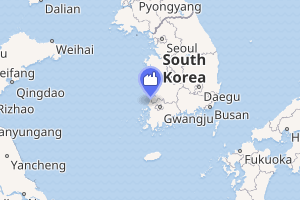Hanbit Nuclear Power Plant
The Hanbit Nuclear Power Plant is a large nuclear power station in the Jeollanam-do province of South Korea. The facility runs at an installed capacity of 5,875 MW. The power station is currently ranked as the fifth largest nuclear power station in the world. The plant's name was changed from Yeonggwang NPP to Hanbit in 2013 at the request of local fishermen.[1]
| Hanbit Nuclear Power Plant | |
|---|---|
_04790184_(8505820561).jpg) Hanbit (formerly Yonggwang) Nuclear Power Plant | |

| |
| Official name | 한빛원자력발전소 한빛原子力發電所 |
| Country | South Korea |
| Location | Jeollanam-do |
| Coordinates | 35°24′54″N 126°25′26″E |
| Status | Operational |
| Commission date | 1986 |
| Operator(s) | Korea Hydro & Nuclear Power |
| Nuclear power station | |
| Reactor type | PWR |
| Power generation | |
| Units operational | 1 × 947 MW 1 × 953 MW 1 × 988 MW 1 × 994 MW 1 × 996 MW 1 × 997 MW |
| Nameplate capacity | 5,875 MW |
| External links | |
| Website | yk |
| Commons | Related media on Commons |
All the units at Hanbit are of the Pressurized Water Reactor (PWR) reactor type. Unit-1 and Unit-2 are 3-loop Westinghouse-designed plants; major components were sourced from foreign firms while auxiliary components and site construction were handled domestically. Unit-3 and Unit-4 are 2-loop Combustion Engineering (C-E) System 80 plants with major components and construction handled domestically under a technology transfer agreement. Unit-5 and Unit-6 are based on the Ulchin (now Hanul) Unit-3 OPR-1000 Korean Standard Nuclear Power Plant design.[2][3]
| Unit | Type | Net Capacity | Construction start | Operation start | Notes |
|---|---|---|---|---|---|
| Hanbit-1 | WH F | 959 | 04 Jun 1981 | 25 Aug 1986 | [4] |
| Hanbit-2 | WH F | 958 | 10 Dec 1981 | 10 Jun 1987 | [5] |
| Hanbit-3 | OPR-1000 | 998 | 23 Dec 1989 | 31 Mar 1995 | [6] |
| Hanbit-4 | OPR-1000 | 997 | 26 May 1990 | 01 Jan 1996 | [7] |
| Hanbit-5 | OPR-1000 | 993 | 29 Jun 1997 | 21 May 2002 | [8] |
| Hanbit-6 | OPR-1000 | 993 | 20 Nov 1997 | 24 Dec 2002 | [9] |
Incidents
In November 2012 security checkups prompted by the Fukushima Daiichi nuclear disaster revealed that from 2003 eight suppliers had forged quality certificates for a delivered 7,682 items to the plant. Of the plant's six reactors two were affected by more than 5,000 of those parts and were consequently shut down, for an expected eight weeks. According to Yonhap news agency the incident was likely to seriously undermine the confidence in South Korean nuclear reactors and could thus impede the country's export of nuclear power plants. Knowledge Economy Minister Hong Suk-woo responded that the "government plans to further increase its efforts to export nuclear reactors. In this regard, the government will quickly provide all necessary and accurate facts to prospective foreign buyers to make sure there is not a single shred of doubt left over the safety of the country's nuclear reactors".[10]
References
- "Korean nuclear plants renamed". World Nuclear News. World Nuclear Association (WNA). 21 May 2013. Archived from the original on 12 June 2013. Retrieved 23 May 2013.
- Nuclear power stations in South Korea Archived 2009-02-02 at the Wayback Machine IAEA.
- "Yonggwang Nuclear Power Complex (영광 원자력발전소)". Nuclear Threat Initiative (NTI). 7 Jan 2014. Archived from the original on 7 January 2014. Retrieved 7 Jan 2014.
- "Hanbit-1". Power Reactor Information System (PRIS). International Atomic Energy Agency (IAEA). 7 Jan 2014. Archived from the original on 7 January 2014. Retrieved 7 Jan 2014.
- "Hanbit-2". PRIS. IAEA. 7 Jan 2014. Archived from the original on 7 January 2014. Retrieved 7 Jan 2014.
- "Hanbit-3". PRIS. IAEA. 7 Jan 2014. Archived from the original on 7 January 2014. Retrieved 7 Jan 2014.
- "Hanbit-4". PRIS. IAEA. 7 Jan 2014. Archived from the original on 7 January 2014. Retrieved 7 Jan 2014.
- "Hanbit-5". PRIS. IAEA. 7 Jan 2014. Archived from the original on 7 January 2014. Retrieved 7 Jan 2014.
- "Hanbit-6". PRIS. IAEA. 7 Jan 2014. Archived from the original on 7 January 2014. Retrieved 7 Jan 2014.
- Gayathri, Amrutha (2012-11-05). "South Korea Shuts Down Nuclear Reactors Due To Unqualified Parts, Warns Of Power Shortages". ibtimes.com. Archived from the original on 2017-02-17. Retrieved 2017-02-16.